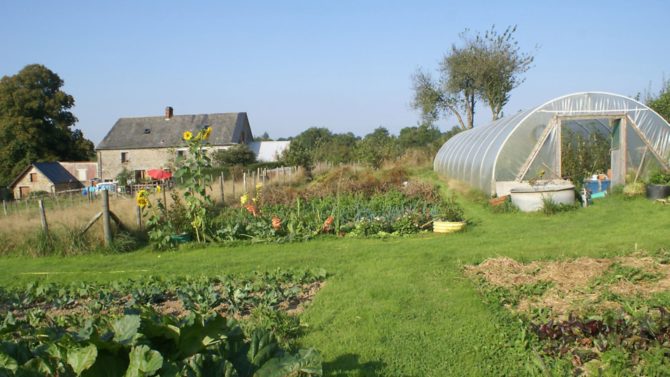A year in my garden in Normandy

British expat Rosie Hill grows a variety of fruit and vegetables in her Normandy garden that shes uses to cook for the family throughout the year…

SPRING in my garden in Calvados
Spring is a very important time and it’s when I really need to get going in the garden. Signs of the new season are all around in the garden: frogspawn in the pond, primroses along the roadside and things beginning to stir in the vegetable patch. There are still a few winter vegetables to harvest (Brussels, leeks, cabbage, kale, parsnips, lambs lettuce, chard, oriental greens) but we are also about to enter the ‘empty gap’ – winter veg will soon be finished and it will be a while before spring plantings are ready. We won’t go hungry yet but I know that I need to get going soon!
Spring is such a special time – a new season full of hope for new harvests to come. Each spring I try to grow something new. Our garden here in Normandy is no warmer than our garden in south-east England but I didn’t have a polytunnel back then. Now I can try all sorts of new things in my plastic friend. This year I have chosen some different tomato and chilli varieties and outside I am planting new pumpkin varieties.
I love that my vegetable patch is right on my doorstep. I can pop out for 10 minutes to do a bit of weeding, etc, and the produce I harvest can be on our plates in minutes – zero food miles and the freshest of tastes. You can’t beat it!

SUMMER in my garden in Calvados
Although we get some rain in Normandy, we regularly enjoy long, warm days and, in the height of summer, it doesn’t get dark until 11pm. We can also bid farewell to the empty gap – that period of few harvests between winter and summer – and now I have fruit and vegetables galore. The first rush of summer harvesting brings some of my favourite produce: soft fruit. I harvest strawberries, currants, gooseberries, tayberries, raspberries and Worcesterberries. On the vegetable front I bring in bucket loads of broad beans, early potatoes, beetroot, lettuce and courgettes. Some is frozen, some bottled and preserved.
The polytunnel in summer is completely full. I grow 10-14 varieties of tomatoes as I love the range of colour, size and flavour this brings. Other polytunnel goodies include peppers, chillies and aubergines – great for making ratatouille!

While I don’t have much of a flower garden, I do grow flowers in the veg patch – sunflowers and gladioli are my favourites. I also plant sweet peas and morning glory to grow up the bean poles and other annuals for cutting. In the polytunnel I have French marigolds and poached egg flowers.
After harvesting, three jobs take up much of my time – weeding, watering and pest control. To help reduce weeds I cover the soil so plants like potatoes get a thick mulch of grass cuttings or straw, and pumpkins, etc, are grown through weed-suppressing fabric. This also helps retain water and I try to only water young or very thirsty plants.
In terms of pest control, I put up various barriers to stop pests getting to my plants. I encourage pest-eating creatures such as ladybirds and I manually remove those pests I find. Luckily, we have fewer slugs and snails here and we have a healthy bird population that eats them up. But pest control is still a never-ending battle and while others may marvel at cabbage white butterflies flitting past, I am out there looking under leaves for their eggs!

Summer is therefore a time of plenty – plenty of work but plenty of produce too. Sitting outside, with wildlife all around you, enjoying a home-produced meal is hard to beat.
___________________________________________________________
Related articles

A year in ny garden in Limousin Gardening in Deux-Sèvres___________________________________________________________
AUTUMN in my garden in Calvados
I think if I had to choose one season that was my favourite in my Normandy garden it would have to be autumn. In autumn, the rush of summer starts to ease off. Mind you, there is still more than enough to keep me busy…
The vegetable garden just shouts ‘autumn’. The trees are full of different colours, cabbages are swelling and late courgettes will sneakily turn to marrows should I not check them every day. It’s as if the plants know the year is turning and this is their last chance to put on growth so there is still a lot of harvesting to be done and back in the kitchen this means lots of freezing and making jams and preserves.

Early autumn still sees harvests of tomatoes, peppers, chillies and aubergines, pumpkins etc, but I know these crops will finish soon. But that does not mean the polytunnel becomes bare, far from it. Other plants that are slowing down outside now thrive under its plastic protection with lettuce, beans and chard, etc, cropping well through autumn. I am now sowing overwintering onions, broad beans and peas which love the protection afforded by the polytunnel. I also have some winter vegetables planted to give us harvests should the weather be severe outside. Now is the time to harvest most of our fruit – autumn raspberries and blackberries do particularly well in Normandy and in our small orchard the apples, pears, plums, damsons and medlars are now ripe.
Each day sees changes in the garden and by late autumn mine is so different from its glory days of summer. Winter brassicas and leeks stand tall whatever the weather but the bean poles are bare, the leaves are falling, the swallows have left and I know we won’t taste freshly picked tomatoes for a while. Thank goodness the freezer is full of ratatouille and shelves are groaning under the weight of bottled tomato purée.
WINTER in my garden in Calvados
Winter in Normandy can be as varied as any English winter. The coldest temperature we have ever seen was -12ºC but often it may not fall below freezing for weeks on-end – rain does always feature quite highly though! This might make you think that I don’t get out in the garden much, and whilst in the very worst of weather this might be true, I certainly have plenty of winter jobs to keep me busy.
The protection offered by the polytunnel means I can overwinter certain plants and get plenty of others started early when the ground outside is still waterlogged or frozen. All these vegetables cannot happen without a well-fed and prepared soil. Winter is the time I add manure from our animals and home-made compost before covering the soil to prevent weeds growing. I then let the worms do their magic, pulling the manure and compost down into the soil. Come springtime, I just have to pull back the fabric, gently fork over the surface and I have enriched soil ready for sowing.
In fairness, I am not out in the garden every day in winter but almost every day we eat produce from there, and on the days I am hiding inside there are always seed catalogues to pour through… I like to grow a few new plants or varieties each year and love nothing more than deciding what they will be. It is also a time for reflection. A time to assess what did well, what failed and why. Sometimes failures are out of my control but at other times I can make improvements. I have been gardening since I was about 10 years old when I found some old seed packets in my grandfather’s shed. However, I am still learning and winter gives me time to talk with other gardeners locally or on forums.
Although the worst of the winter weather may still be to come, I also know that spring is on her way and soon I will see seedlings in the cold frame as another gardening year begins…
Rosie Hill, her husband Simon and their two sons live in the Calvados department of Normandy and run and family-friendly eco-gîtes. See more at eco-gites.eu
Other articles you might like:
Gardening in Charente-MaritimeGardening in ArdècheGardening in AuvergneGardening in Dordogne
Share to: Facebook Twitter LinkedIn Email


